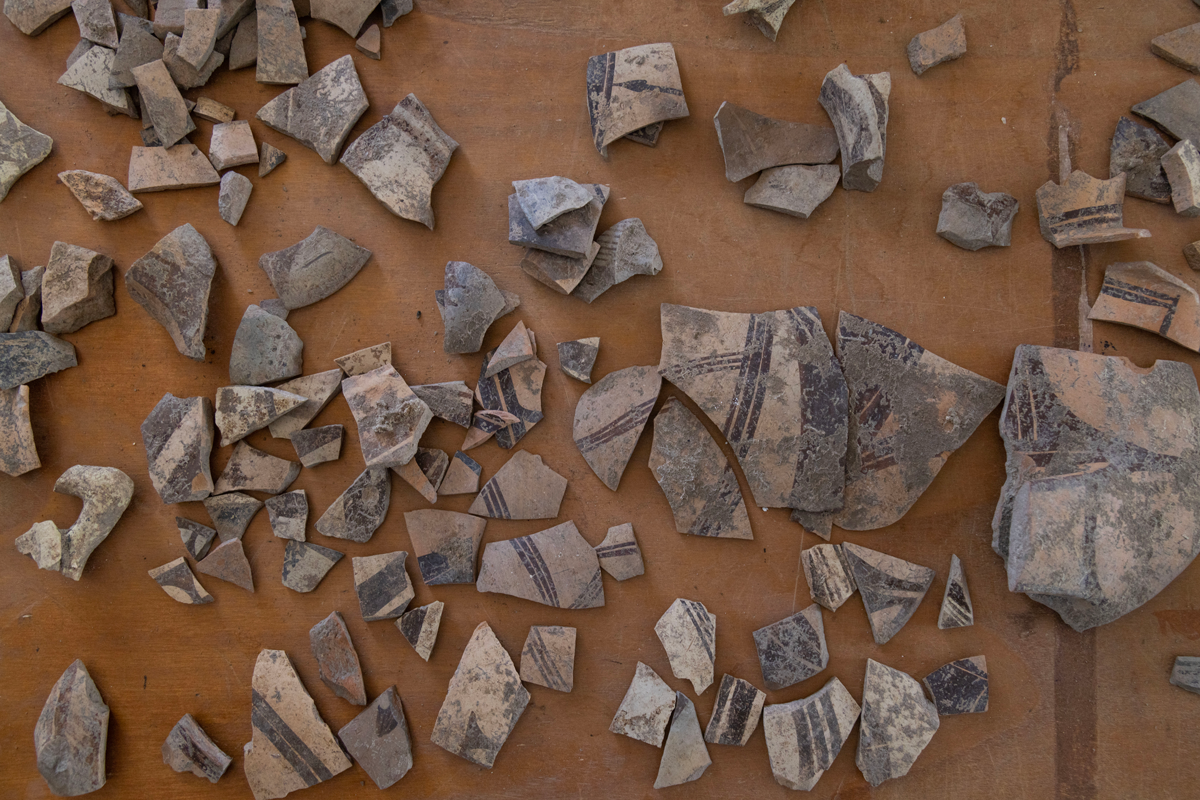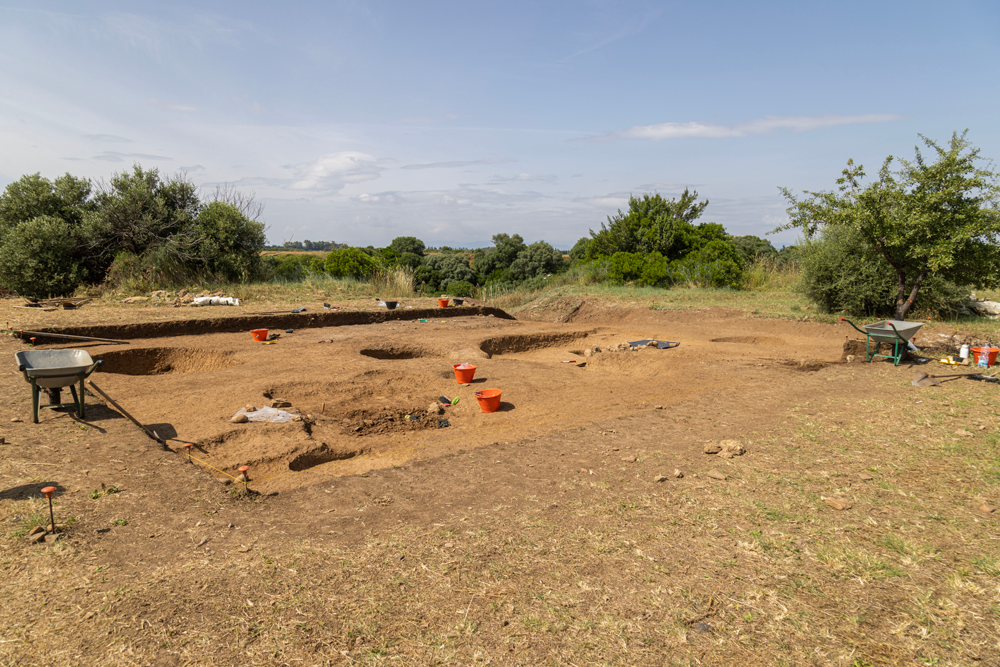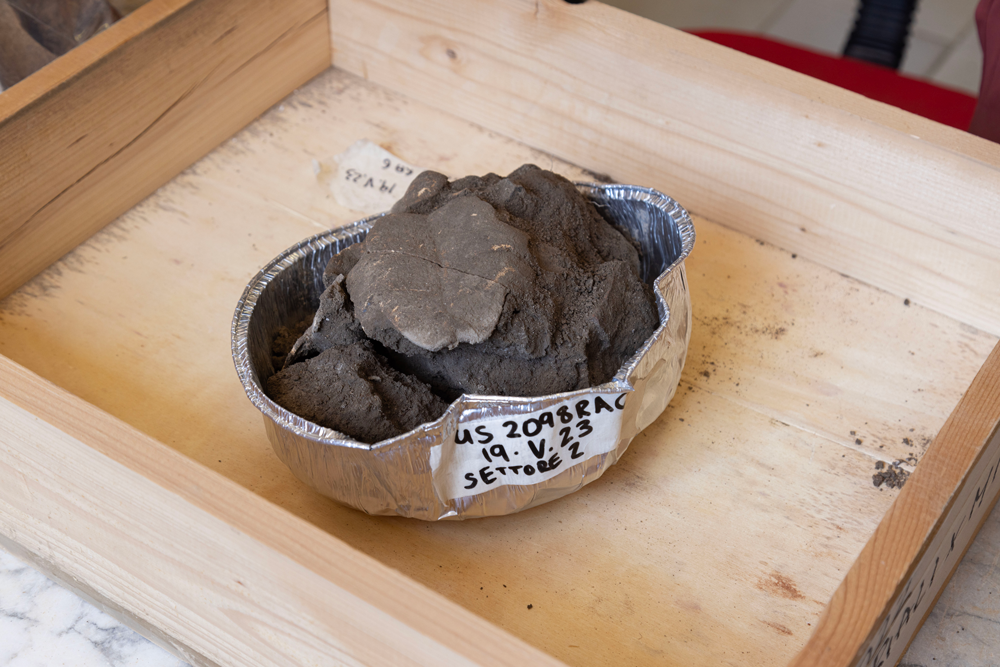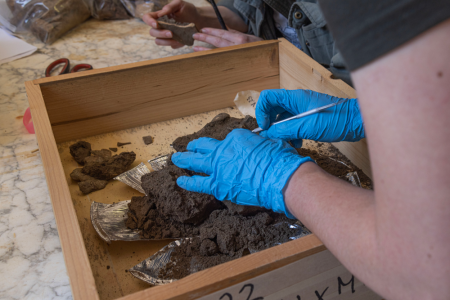
BY Written by Sara Laux. Photos and video by Colin Czerneda.
January 17, 2024
A trip to the past with the
Metaponto Archaeology Project
The Metaponto Archaeological Project is nothing short of a collection of puzzles.
There are the brain teasers: How did the Greek settlers of the 8th and 7th centuries BCE interact with the indigenous Oenotrian population? And why was the dig site, an Oenotrian settlement now known as Incoronata Greca, abandoned?
The logic questions: If things that look like offerings have been found, should there be a temple nearby?
And then there are the literal jigsaw puzzles: How do those pottery sherds fit together, anyway? Are they pieces of an amphora, or a skyphos? Are they actually Greek, or do they just look Greek?
Slowly, slowly, the picture is starting to take shape.
In the main piazza in the town of Metaponto, a bust of Greek philosopher Pythagoras stares impassively across the square at the large statue of Jesus mounted on a contemporary church, the Chiesa San Leone Magno.
Behind Pythagoras, whose bust is encased in a pyramid of plexiglass triangles, is the “banca” – a former bank that now serves as the lab, illustration and photography studios, artifact cleaning area, and storage facility for the Metaponto Archaeology Project, an ongoing collaboration between McMaster and St. Mary’s University in Halifax.
In a summer that’s seen a lot of attention on fantasy archaeology (hello, Indiana Jones and the Dial of Destiny), real-life researchers and graduate students from McMaster’s department of Greek and Roman Studies in the Faculty of Humanities have teamed up with undergrads and professors from Saint Mary’s to uncover the early history of interactions between the indigenous people of this area of Italy and the Greek settlers in the 8th century BCE.
Working under the supervision of the Superintendency of Cultural Resources of Basilicata, the local branch of the Italian Ministry of Culture, the team is working together to solve mysteries that are almost 3,000 years old.

The idea that there were civilizations in Italy before the Greeks arrived is surprising for some – but that’s to be expected, says Spencer Pope, co-director of the Metaponto Archaeological Project. After all, the Greeks didn’t write much about the other civilizations they encountered as they colonized what is now southern Italy – and those other cultures didn’t write at all.
What’s left, explains Pope, is what those indigenous groups left behind – and the story these artifacts can tell.
“By looking at material culture like pottery production and domestic architecture, we can get a more accurate picture of interaction and even agency by all population groups, both indigenous and Greek,” he says. “We’re getting a more complete picture of the Mediterranean and all the participant culture groups – and we’re so grateful to the Italian authorities who have allowed us to do that.”
With its research, the project is helping provide a more accurate view of what life was like for the inhabitants of the area almost 3,000 years ago – including the Oenotrians, a civilization that’s long been a footnote in the historical narrative of the area.

With separate workrooms, floor-to-ceiling shelves of boxes packed with catalogued finds, running water and a flushing toilet, the banca feels like a world away from a hot, dusty dig site. The work that happens here, though, is no less challenging.
This is where the students who are doing the digging bring their finds at the end of the day, which include pottery sherds, small containers, lumps of a building material known as concotto and animal bones. Undergraduate students from St. Mary’s sit at a long sink behind a row of shelves, gently washing the dirt off the finds. Large wooden tables in the biggest of the workrooms are covered in sherds that have been cleaned and sorted and are ready to be catalogued.
Today, there’s a break from washing as they work on the skeleton of a tortoise that the team has named “Mortimer.”

Under the guidance of Angela Trentacoste, a zooarchaeologist and the Peter J. Smith Fellow in Archaeology at the British School in Rome, the SMU students are learning how to conduct a micro-excavation – a way to excavate a find that involves bringing it to the lab still encased in earth, then painstakingly removing the earth using brushes and a variety of tools that include wooden skewers, a variety of metal picks and small wooden spatulas.
It’s exacting, fiddly work, and it takes several hours to fully extract Mortimer from his earthy tomb. These kinds of finds are important, though, because they can provide clues about what a population may have eaten, how they prepared their food and how they used the land around them.

And for a society like the Oenotrians who didn’t leave any written records, animal remains and other elements of material culture are important pieces of the puzzle in recreating the story of their lives.
Finds like Mortimer are also key to providing a more balanced history of the area – one that isn’t simply based on Greek literary sources, but on archaeological evidence that gives the indigenous perspective equal weight alongside those of the colonizers.
“The main scope of this project is to give voice to the populations that have not been considered part of ‘proper history’ because they didn’t leave written records,” explains Sveva Savelli, an associate professor of ancient studies and intercultural studies in the Department of Languages and Culture at St. Mary’s, and the co-director of the dig.
“Greek literary sources tell us a lot about what happened on this land, but it’s history that’s been written by the winners – we don’t have the indigenous perspective. We’re trying to fill in the blanks and see if we can create a narrative that includes the dynamics of colonization. Our work here is to create a frame for these voices to be heard.”

Incoronata Greca sits high on a plateau above the Basento River Valley. Today, the best way to describe the weather is “unsettled.” The sun’s out, but the wind is blowing and there are ominous clouds in the distance.
Adrian Proestos, though, isn’t looking at the view. He’s concentrating on getting the mid-morning coffee ready for the 10 or so people – undergrads from SMU, grad students from McMaster, and local workers – who have been working at the site since 7 a.m.

Using a small camp stove set in a bucket to reduce wind and save fuel and a stove-top espresso maker, Proestos, a PhD candidate in Greek and Roman Studies and the site’s self-proclaimed “fluids engineer” (he also maintains the stock of water bottles) hands shots of espresso around to those who want one.
The settlers on this site wouldn’t have recognized the hot, bitter brew – coffee didn’t make it to Italy until 1600 CE – but the silhouette of a person bending over a fire to prepare sustenance would not have been out of place on this plateau.
The team has evidence of it.
This year’s excavation has unearthed the remains of a capanna, or small house, that would have been built of reeds with a timber frame, and finished with concotto, a plaster-like sundried clay. While the structure of the cabana is long gone, part of a collapsed wall, its post holes and some pieces of concotto remain, making it easier to determine its footprint.
The team can tell that it had a recessed floor, and they have uncovered a surface that was likely used for cooking, as well as remains of cooking pots nearby.
It’s an important find – even though there aren’t great blocks of limestone or other monumental remains, the capanna is good evidence that Oenotrians did, indeed, live on the site. Because the team hasn’t found evidence of Greek building in this spot, it’s also likely that this capanna existed before the arrival of the Greeks.
This capanna, along with the pottery sherds, animal remains and other items found by the team, brings the daily life of the Oenotrians into sharper focus.
“It’s not useful to limit your view to a single object, but to place them in a context that includes the relationship with the landscape, with the environment – that’s what helps you tell the story,” says Savelli. “It’s only when you look at the ecosystem as a whole that you can try to say something about ancient groups.”
Of course, there are now more questions. How many houses were there, and how were they arranged? Was there a hierarchy of big and small dwellings? What type of pottery were they using – locally produced and indigenous in origin, or was it Greek?
“These are very big questions,” chuckles Pope. “And the answer comes with more excavation.”
Proestos, whose PhD research focuses on the connectivity between Incoronata and other Iron Age sites, agrees.
“Everything to learn is out here,” he says. “Archaeology is a process, and as we’re constructing a narrative, constructing a story, we’re not only reconstructing the past but telling a story about ourselves and what we think is valuable.
“The act of trying to tell the Oenotrian story, however it might be reconstructed, is why we’re here.”
Want to learn more about the Metaponto Archaeology Project? Click here to explore the history of the project, learn more about the student experience and discover other archaeological initiatives in Italy.

